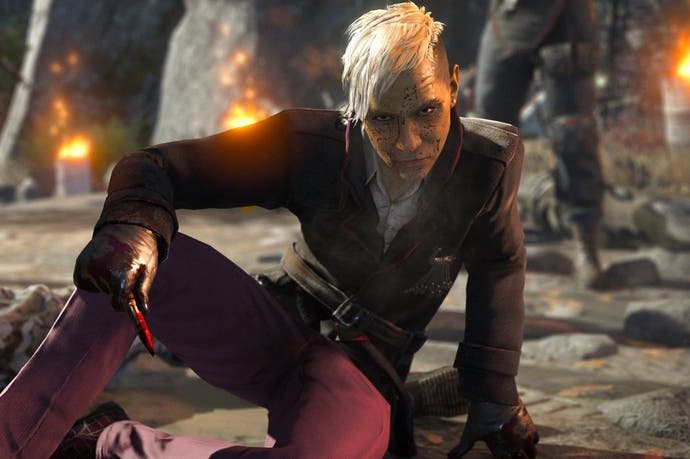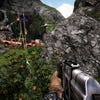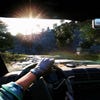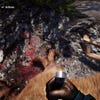Digital Foundry vs Far Cry 4
Frame-rate tests and tech analysis on Ubisoft's next big release.
Far Cry 3 stretched last-gen consoles like no other, but its sequel on PlayStation 4 gives Ubisoft Montreal a chance to unleash the engine's true potential. With its gorgeous Himalayan horizon, our original hands-on at E3 2014 applauded a very well-rounded technical showcase for Sony's console, one which its creative director confirms has 1080p resolution as its target. But with final PlayStation 4 code to hand, does the game deliver a generational leap, and with this peak console resolution in mind, can it do so at a respectable frame-rate, bearing in mind the issues seen this week with Assassin's Creed Unity?
Through a rapid pixel-count, it's easy to see the PS4 absolutely delivers on this full 1920x1080 promise - with none of the frame-rate problems seen in its Ubisoft stablemate. For every pixel we a get new line of visual information, letting us soak in every detail of Ubisoft Montreal's ice-peaked terrain from afar. However, by nature Far Cry 4 also boasts a eclectic mix of visual elements; from rock geometry and dangling flag-lines, to broad swathes of foliage and fur shaders. While a 1080p base image is a powerful starting position, image treatment tailored to the each game's visual style is still crucial, and Far Cry 4 deserves extra credit in this department.
Ubisoft delivers a unique solution here. To tackle all of these elements as best it can, a new Hybrid Reconstruction Anti-Aliasing (HRAA) system is in place for the game. As gleaned from developer Michal Drobot's SIggraph 2014 presentation, this takes common wisdom from the best post-processing methods available, matching SMAA for image clarity in static moments, while also attempting to iron out any shimmer artefacts owing to a lack of temporal sampling.
In practise on PS4, HRAA very successfully attacks Far Cry 4's jagged edges while avoiding residual blur to texture-work - a shortcoming pinned on lower-quality presets of the popular FXAA. Geometric aliasing is tricky to catch indeed, and in dealing with the final rasterizsd target, sub-pixel elements are also thoroughly treated. In static shots, the game still retains its sharpness in all the right places.
But the secondary goal is in improving how this AA works in motion. High contrast elements, such as gaps between tree leaves and mesh patterns - the typical culprits for temporal flicker - now benefit from the blending of current and former frames to reduce visual noise. The net result is very little shimmer to these elements as we pan around, calling to mind the existing TXAA method used on PC.
As a hybrid approach it works surprisingly well, and to top it off, it targets a minute render budget of around 1ms when working with a 1080p image. In all, this is a swift turnaround comparable to other post-process methods. The only stone unturned, to our eyes, is on the game's fur shaders, with wildlife up close still producing a visible pixel crawl. Even so, it tackles many of the bizarre curve-balls Far Cry 4 has to throw, and makes a promising case for its use in other future open-world games.
While we've yet to play the Xbox One version, the PS4 game's image quality stands several leagues ahead of its predecessor's cropped, heavily processed 1280x704 output on last-gen consoles. It's a level of clarity that demands a ramp-up in its other visual facets, and thankfully Ubisoft Montreal makes every effort to deliver a top-end experience on PS4.
Texture mapping is massively improved, for example, especially on cliff-sides that once suffered from low resolution patches on last-gen. And while tessellation isn't in evidence across geometry for PS4, the base resolution across cobbled walls is convincingly high as a stand-in. We'll report on the PC version in due course to see if this is at all an option on its maxed preset, but right down to the reasonable grade of anisotropic filtering, the console version appears to shoot high.
The same goes for world detail; woodland density is on par with Far Cry 3's tropics on a maxed-out PC, meaning at last, console users can play the game with limited pop-in. Vegetation renders far below a hang-glider's view on Sony's latest hardware - where the obvious fade-in techniques used on PS3 and Xbox 360 are now a things of the past. That said, minor world details still apparate at points, as you might expect for such a massive world. Rapid, zip-line descents bring this out more noticeably, though the switchover on rocks now kicks in at a far broader range.
It's a gorgeously articulated world then. But one main, lingering gripe remains in the series' static terrain. Save for the crumbling blocks of ice at mountain peaks, very little of Far Cry 4's landscape is truly affected by your interaction. Ragdoll physics have a role on enemies, of course, but chip damage to environments is sorely missing, while the illusion of a living, breathing wilderness could benefit from any sort of motion to foliage as we wade through thickets.
Even at a distance, Ubisoft Montreal's shadows also hold a pristine, smooth form on PS4. It abandons the hatch-style rendering artefacts seen on PS3's percentage-closer filtering shadows in the last game, and thankfully, also the pixelated flicker of those on the old 360 release. As a bonus, ambient occlusion now falls closer in line with top-end methods such as HBAO+ too, meaning the thick, dark silhouettes around last-gen hands (or objects close to walls) are replaced by subtle shades. It's a full-on improvement here.
To round off the settings check list, post-process effects also deserve a mention. In this PS4 release we get the full suite, starting with a new motion blur added to full screen-pans, not seen before on console. On top of that, we get sparing per-object version of the effect too, typically across player hands during grenade lobs or gun reloads. Sadly, we don't see the light shaft trick of the maxed PC Far Cry 3 here; instead, just a lens flare effect creeping in from the sun at low angles. The lighting model shows no obvious limits otherwise, and everything (besides yourself and flag-lines) is mirrored back as reflections in the game's lakes and rivers.
But having dipped into the PS3 and Xbox 360 versions of the previous game for a refresher, the absolute biggest upgrade for the newer entry on PS4 is its frame-rate. Where once we had a 20-30fps read-out with unrelenting tear across the screen, Sony's new hardware clears everything up. Despite its top-grade visual settings, the use of HRAA, plus an ambitious native 1920x1080 output, this game runs at a near faultless 30fps.
Based on four to five hours of testing, perceptible drops from 30fps are incredibly rare. For example, Far Cry 4's opening car chase produces one momentary, blunt stutter to the mid 20s during grenade fire, but after that point it's smooth sailing. Tearing is basically a no-show as well; an adaptive v-sync setup is in place once more for console, but it manifests as only single tears at the very top of the screen, coinciding with equally rare frame-rate hiccups. In other words, Far Cry 4 may not match a PC gamer's potential 60fps boast, but Ubisoft Montreal hits the target it set for itself on console - and the all-important consistency is there.
Looking back on prior PS3 and 360 versions, the Dunia 2-driven Far Cry experience clearly proved too progressive for the hardware of the time. Now we see an unleashed experience on PS4, giving us the quality of play we hoped for in the first place. Disappointments are few and minor, such as the game missing out on Assassin's Creed Unity's beautiful facial mo-cap tech. Instead, Ubisoft Montreal opts for a more approximated approach to lip-sync that doesn't showcase much of a generational leap. But on the whole, the package is a very strong initial effort on new hardware.
The solid performance here is reminiscent of the strong showing of Assassin's Creed 4: Black Flag last year - there's the sense that Ubisoft has built upon and refined an existing engine technology and in PlayStation 4 we finally have the hardware required to enjoy a good balance between excellent visuals and good, consistent performance. Right now, we've only seen the game running on the Sony platform, but we're intrigued to see how Far Cry 4 scales on PC, and there's also the small matter of Xbox One to address. We suspect that it may run at a lower resolution than the PS4 build, but assuming it implements HRAA, the tell-tale temporal shimmering that's amplified by upscaling should be much less of an issue - it could be the most fascinating resolution comparison in quite some time. We'll update you on all three versions next week.





























